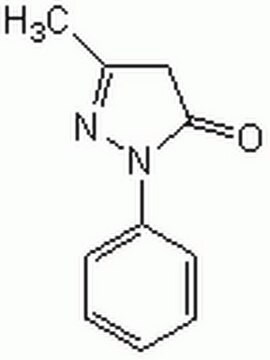SML0398
Salsolinol hydrobromide
≥96% (HPLC)
别名:
(R,S)-Salsolinol hydrobromide, 1,2,3,4-Tetrahydro-1-methylisoquinoline-6,7-diol hydrobromide, 1-Methyl-1,2,3,4-tetrahydroisoquinoline-6,7-diol hydrobromide, 1-Methyl-6,7-dihydroxy-1,2,3,4-tetrahydroisoquinoline 1,2,3,4-Tetrahydro-1-methylisoquinoline-6,7-diol hydrobromide; 1-Methyl-1,2,3,4-tetrahydroisoquinoline-6,7-diol hydrobromide;
登录查看公司和协议定价
所有图片(1)
About This Item
经验公式(希尔记法):
C10H13NO2 · HBr
CAS号:
分子量:
260.13
MDL號碼:
分類程式碼代碼:
51111800
PubChem物質ID:
NACRES:
NA.77
推荐产品
品質等級
化驗
≥96% (HPLC)
形狀
powder
儲存條件
desiccated
顏色
white to brown
溶解度
H2O: 5 mg/mL (warmed; clear solution)
儲存溫度
2-8°C
SMILES 字串
Br.CC1NCCc2cc(O)c(O)cc12
InChI
1S/C10H13NO2.BrH/c1-6-8-5-10(13)9(12)4-7(8)2-3-11-6;/h4-6,11-13H,2-3H2,1H3;1H
InChI 密鑰
OGMGXKJQIOUTTB-UHFFFAOYSA-N
一般說明
Salsolinol (6,7-dihydroxy-1-methyl-1,2,3,4-tetrahydroisoquinoline) is present in various edibles. It is available as R and S enantiomers. R-salsolinol in predominantly found in the brain tissue of humans.
生化/生理作用
Salsolinol is the condensation product of acetaldehyde and dopamine. Salsolinol is a potential neurotoxin suspected to contribute to alcohol abuse. It appears that salsolinol excites the ventral tegmental area (VTA) dopamine neurons indirectly by activating μ-opioid receptors (MORs), which inhibit GABA neurons in the VTA.
Salsolinol, a neurotoxin, can serve as a prolactin-releasing factor and an etiological factor in the tuberoinfundibular pathway and in Parkinson′s disease (PD), respectively. It can also act as a modulator of catecholaminergic neurotransmission in the nigrostriatal pathway. In central nervous system, salsolinol can change the role of dopaminergic neurons and dopamine metabolism.
特點和優勢
This compound is featured on the Dopamine and Norepinephrine Metabolism page of the Handbook of Receptor Classification and Signal Transduction. To browse other handbook pages, click here.
訊號詞
Warning
危險聲明
危險分類
Eye Irrit. 2 - Skin Irrit. 2 - STOT SE 3
標靶器官
Respiratory system
儲存類別代碼
11 - Combustible Solids
水污染物質分類(WGK)
WGK 3
閃點(°F)
Not applicable
閃點(°C)
Not applicable
Magdalena Kurnik-Łucka et al.
Neurotoxicity research, 37(2), 286-297 (2019-11-17)
Salsolinol (6,7-dihydroxy-1-methyl-1,2,3,4-tetrahydroisoquinoline), widely available in many edibles, is considered to alter the function of dopaminergic neurons in the central nervous system and thus, multiple hypotheses on its either physiological and/or pathophysiological role have emerged. The aim of our work was
Adriana Prado et al.
Journal of applied toxicology : JAT, 35(2), 219-227 (2014-05-24)
Unforeseen toxic effects contribute to compound attrition during preclinical evaluation and clinical trials. Consequently, there is a need to correlate in vitro toxicity to in vivo and clinical outcomes quickly and effectively. We propose an expedited evaluation of physiological parameters
我们的科学家团队拥有各种研究领域经验,包括生命科学、材料科学、化学合成、色谱、分析及许多其他领域.
联系技术服务部门








